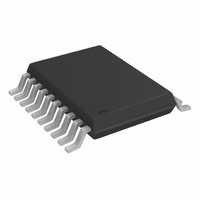AD5930YRUZ Analog Devices Inc, AD5930YRUZ Datasheet - Page 20

AD5930YRUZ
Manufacturer Part Number
AD5930YRUZ
Description
IC GEN PROG FREQ BURST 20TSSOP
Manufacturer
Analog Devices Inc
Datasheet
1.AD5930YRUZ.pdf
(28 pages)
Specifications of AD5930YRUZ
Resolution (bits)
10 b
Master Fclk
50MHz
Tuning Word Width (bits)
24 b
Voltage - Supply
2.3 V ~ 5.5 V
Operating Temperature
-40°C ~ 125°C
Mounting Type
Surface Mount
Package / Case
20-TSSOP
Synthesizer Type
Frequency
Frequency
25MHz
Supply Voltage Range
2.3V To 5.5V
Supply Current
2.4mA
Operating Temperature Range
-40°C To +105°C
Digital Ic Case Style
TSSOP
No. Of Pins
20
Pin Count
20
Screening Level
Automotive
Package Type
TSSOP
Lead Free Status / RoHS Status
Lead free / RoHS Compliant
Lead Free Status / RoHS Status
Lead free / RoHS Compliant, Lead free / RoHS Compliant
Available stocks
Company
Part Number
Manufacturer
Quantity
Price
Company:
Part Number:
AD5930YRUZ
Manufacturer:
Intel
Quantity:
33
AD5930
Therefore, in this example, a time interval of 20 ns × 2047 = 40 µs
is the maximum, with the minimum being 40 ns. For some
applications, this maximum time of 40 µs may be insufficient.
Therefore, to cater for sweeps that need a longer increment
interval, time-base multipliers are provided. Bit D12 and Bit D11
are dedicated to the time-base multipliers (see Table 12). A more
detailed table of the multiplier options is given in Table 13.
Table 13. Time-Base Multiplier Values
D12
0
0
1
1
If MCLK is 50 MHz and a multiplier of 500 is used, then the
base interval (T
a multiplier of 500, the maximum increment interval is 10 µs ×
2
gives the user enhanced flexibility when programming the
length of the frequency window, because any frequency can be
output for a minimum of 40 ns up to a maximum of 20.5 ms.
Length of Sweep Time
The length of time to complete a user-programmed frequency
sweep is given by the following equation:
Burst Time Resister (T
As previously described in the Burst Output Mode section, the
AD5930 offers the user the ability to output each frequency in
the sweep for a length of time within the increment interval
(t
(t
option must be enabled. This is done by setting Bit D7 in the
control register to 0.
Similar to the time interval register, the burst register can have
its duration as:
•
•
The address for this register is given in Table 14.
11 − 1
INT
INT
), and then return to midscale for the remainder of the time
– T
T
A multiple of cycles of the output frequency
A multiple of MCLK periods
= 20.5 ms. Therefore, the option of time-base multipliers
SWEEP
BURST
D11
0
1
0
1
= (1 + N
) before stepping to the next frequency. The burst
BASE
) is now (1/(50 MHz) x 500)) = 10 µs. Using
INCR
Multiplier Value
Multiply (1/MCLK) by 1
Multiply (1/MCLK) by 5
Multiply (1/MCLK) by 100
Multiply (1/MCLK) by 500
) × T
BURST
)
BASE
Rev. 0 | Page 20 of 28
Table 14. T
D15
1
1
However, note that when using both the increment interval
(t
should be the same. In instances where they differ, the AD5930
defaults to the value programmed into the t
Similarly, Bit 12 and Bit 11, the time-base multiplier bits, always
default to the value programmed into the t
ACTIVATING AND CONTROLLING THE SWEEP
After the registers have been programmed, a 0 ≥ 1 transition on
the CTRL pin starts the sweep. The sweep always starts from
the frequency programmed into the F
the value in the ∆F register and increases by the number of
steps in the N
burst duration of each frequency can be internally controlled
using the t
pin. The options available are:
1.
2.
3.
1. Auto-Increment, Auto-Burst Control
The values in the t
sweep. The AD5930 bursts each frequency for the length of
time programmed in the T
for the remainder of the interval time (t
To set up the AD5930 to this mode, CW/BURST (Bit D7) in the
control register must be set to 0, INT/EXT BURST (Bit D6)
must be set to 0, and INT/EXT INCR (Bit D5) must be set to 0.
Note that if the part is only operating in continuous mode, then
(Bit D7) in the control register should be set to 1.
2. External Increment, Auto-Burst Control
The time interval, t
The first 0 ≥1 transition on the pin starts the sweep. Each
subsequent 0 ≥1 transition on the CTRL pin increments the
output frequency by the value programmed into the ∆F register.
For each increment interval, the AD5930 outputs each
frequency for the length of time programmed into the T
register, and outputs midscale until the CTRL pin is pulsed
again. Note that for this mode, the values programmed into Bit
D13, Bit D12, and bit D11 of the T
INT
) and burst time register (T
auto-increment, auto-burst control
external increment, auto-burst control
external increment, external burst control
D14
0
0
INT
BURST
and T
INCR
D13
0
1
Register Bits
register. However, both the time interval and
INT
INT
BURST
D12
x
x
and T
, is set by the pulse rate on the CTRL pin.
registers, or externally using the CTRL
BURST
BURST
D11
x
x
BURST
register, and outputs midscale
registers are used to control the
BURST
), the settings for Bit D13
D10 to D0
11 bits of <0…10>
Fixed number of output
waveform cycles.
11 bits of <0…10>
Fixed number of clock
periods.
START
register are used.
INT
INT
register. It changes by
– T
INT
register.
BURST
register.
).
BURST













